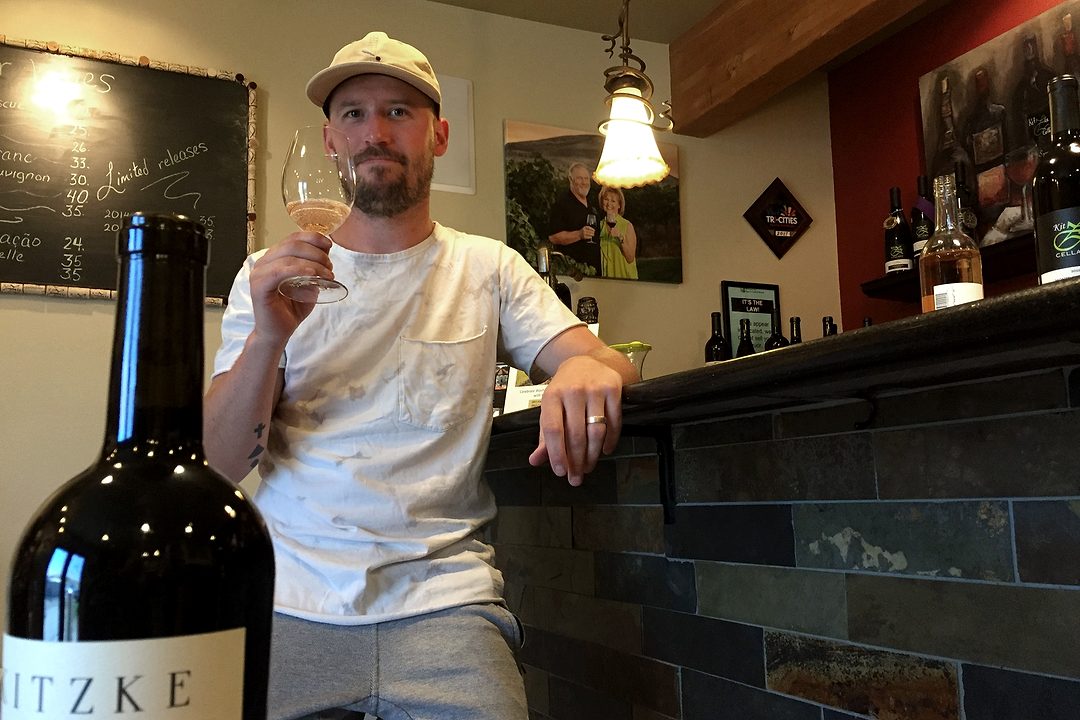
Home » Candy Mountain may be Washington’s newest wine region
Candy Mountain may be Washington’s newest wine region

November 14, 2019
By Andy Perdue
The American Viticultural Areas system in the United States is a way for the federal government to officially recognize a wine grape growing region. At this point, Washington has 14 federally approved AVAs.
In the Tri-Cities, wineries and grape growers are awaiting approval of the state’s newest AVA: Candy Mountain. The brown hill in Richland is one of five currently proposed AVAs.
 Andy Perdue,
Andy Perdue,The state’s first one was the Yakima Valley, established in 1983; the largest is the Columbia Valley, which takes up a third of the state and helps to define what we think of as Washington wine country.
To get an AVA approved is a long, arduous process that includes showing a history of grape growing, as well as how the newly defined region is different than others. Once approved, an AVA can be used as a marketing tool and be listed on a wine label.
For an example, a bottle of red wine that features “Napa Valley” on the label will not only signal the customer about its provenance, but also often commands a higher price because of the reputation of the quality of grapes grown.
The five proposed AVAs are working their way through the process with the U.S. Alcohol and Tobacco Tax and Trade Bureau, a division of the Treasury Department. Until 2003, it was known as the ATF.
The proposed Candy Mountain AVA would be about 900 acres in size and partly within both the Yakima and Columbia Valley AVAs. It is home to one existing winery and three vineyards, making it among the smallest AVAs in the Pacific Northwest.
The Candy Mountain petition was submitted by Kevin Pouge, a geology professor at Whitman College in Walla Walla and viticulture consultant who wrote and shepherded The Rocks District of Milton-Freewater AVA in Oregon, south of downtown Walla Walla.
Paul and Vicki Kitzke moved to Candy Mountain in 2000, planting apples and cherries. At the urging of a neighbor, they also planted eight acres of wine grapes, including Cabernet Sauvignon, Cabernet Franc, Sangiovese and Syrah. They also bought a bit of fruit from vineyards on Red Mountain and in the Horse Heaven Hills.
Kitzke Cellars in Richland released its first wines five years later. The early wines were crafted by Charlie Hoppes, the acclaimed winemaker behind Fidelitas Wines who has an estate vineyard on Red Mountain and a winemaking facility in Richland.
After graduating from Richland High School, the Kitzkes’ son Seth moved to Seattle, where he earned a degree in winemaking from South Seattle College while working for such wineries as Brian Carter Cellars in Woodinville, Fidelitas and Smasne Cellars in the Yakima Valley, as well as Charles Smith.
In addition to taking over winemaking duties for the family business, he also launched a brand called UpsideDownWines, which he describes as a “pour it forward” operation that supports charities with the proceeds.
When the Candy Mountain AVA is approved by the federal government, likely later this year, Kitzke will begin using the new designation on their labels.
In addition to Kitzke, Premiere Vineyards also has planted Candy Mountain Vineyards, part of a consortium of vineyards that fund a teachers’ retirement fund. It also owns several vineyards in Walla Walla. Acclaimed Walla Walla wineries such as L’Ecole No. 41 and Long Shadows Vintners both use grapes from Candy Mountain.
In 2016, the Friends of Badger Mountain bought 195 acres on Candy Mountain land and built a trail that opened in June 2017 with the help of 240 volunteers.
Candy Mountain was created by the Ice Age Floods, a series of up to 80 outburst floods caused nearly 10,000 years ago when an ice dam in northern Idaho failed, releasing the waters from Glacial Lake Missoula in western Montana. The series of floods helped shape Eastern Washington. Remnants of the floods are still evident on Candy Mountain in the form of granite boulders called erratics that drifted into the Tri-Cities inside icebergs that began their journey in Alberta, Canada. The floods also brought in sandy soil as well in the subsequent centuries. The combination of soils, lack of rain and the region’s perpetually sunny skies combine to make the Columbia Valley among the premier grape-growing regions in the world.
Seth notes Cabernet Franc grapes grown on Candy Mountain are texturally different from grapes grown elsewhere. And the variety’s distinctive herbal notes have been notably absent from examples made from Candy Mountain fruit.
The sandy soils, south-facing slope and light precipitation—less than 10 inches annually—combine to make Candy Mountain a unique grape-growing region. The deep and rich fruit flavors, early ripening and plentiful tannins combine to make the wines texturally similar to nearby Red Mountain, perhaps Washington’s most famous wine region.
Because of the lack of rainfall, grapevines require some irrigation. The Kitzkes get enough for their vines from a well. A layer of caliche also helps the soil retain moisture. This past vintage, Seth said he didn’t turn on his vineyard irrigation until the middle of summer. Grapevines typically need less than half the water required for orchards and other crops.
One of the few mysteries is how Candy Mountain got its name. Seth believes he has the answer. A few years ago, he was pouring wine at a Seattle event when a woman came by his table and told the story of how her father owned most of the land on Candy Mountain. Apparently he had an entrepreneurial bent, and, admiring Walt Disney, thought the brown hill would be perfect for a theme park and renamed Candy Mountain with that in mind.
Andy Perdue, editor and publisher of Great Northwest Wine and founding editor of Wine Press Northwest magazine, is the wine columnist for The Seattle Times.
Local News
KEYWORDS november 2019




